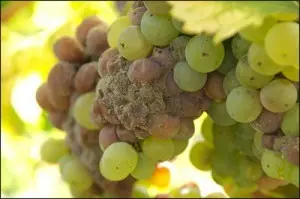Noble wine mold – Botrytis cinerea
 The wines that most inspire confidence, honey or gleaming gold, fragrant without overpowering, vibrant and penetrating, are those wines that are obtained from grapes afflicted with noble mold. To distinguish this state of grape bunches from harmful rot, the ash-colored mold Botrytis cinerea is referred to as “noble mold” or “noble rot”. When it hits healthy, fully ripened white grapes, it dries up their flesh under the intact skin to a state of concentrated essence. If the mold infects unripe berries damaged by insects or heavy rain, destroys the skin and allows harmful bacteria to enter the flesh, it is called gray mold, and it can be a great danger to the crop. It also breaks the pigmentation of bright red berries, giving the wine a dull greyish color.
The wines that most inspire confidence, honey or gleaming gold, fragrant without overpowering, vibrant and penetrating, are those wines that are obtained from grapes afflicted with noble mold. To distinguish this state of grape bunches from harmful rot, the ash-colored mold Botrytis cinerea is referred to as “noble mold” or “noble rot”. When it hits healthy, fully ripened white grapes, it dries up their flesh under the intact skin to a state of concentrated essence. If the mold infects unripe berries damaged by insects or heavy rain, destroys the skin and allows harmful bacteria to enter the flesh, it is called gray mold, and it can be a great danger to the crop. It also breaks the pigmentation of bright red berries, giving the wine a dull greyish color.
Wines made with Botrytis include the French Sauternes, the Hungarian Tokaj and the famous German sweet wines. They cannot be obtained every year, since the growth of noble mold directly depends on the combination of heat and humidity in nature after the grapes have ripened. In a good year, early-maturing, thick-skinned grapes can allow Botrytis to do its job before bad weather sets in; at the same time, the skin will remain intact under the destructive influence of mold, and it will also protect the pulp of the berries from contact with air.
Noble mold invades vineyards from time to time, and even on individual bunches its action will be gradual. The same bunch may contain shriveled, moldy berries, while other berries may still be swollen with brown skin, softened by initial exposure to mold, and some of the berries may be firm, ripe and not at all affected by green fungus.
In order for the noble mold to have its effect on the character of the wine, individual berries should be plucked from the bunch as soon as they are sufficiently wrinkled, but not completely dry. It is necessary to pick the berries from the same vine several times – often five, six, seven or more times in a period that in some years stretches to months. At the same time, each time the harvested grapes are subjected to a separate fermentation.
Two special properties of noble molds affect the structure and taste of the wine and create a difference between wines with Botrytis and sweet wines made from grapes that are dried in conventional kilns. In this case acid and sugar are concentrated by loss of moisture, without changing the composition of the grapes, while Botrytis, feeding on acid with sugar, produces chemical changes in the grapes, creating new elements that change the bouquet of the wine. Since the mold consumes more acid than sugar, the acidity of the wort decreases. In addition, Botrytis mold produces a special substance that prevents alcoholic fermentation. In the must obtained from partially dried berries, whose chemical composition has remained unchanged, alcohol-resistant yeast bacteria are able to ferment sugar into alcohol up to 18 ° -20 °. But the high concentration of sugar in grapes with noble mold means a correspondingly high concentration of mold, which quickly inhibits fermentation. For example, in Sauternes wines, the perfect balance is achieved by sugar, which is able to turn into 20 ° alcohol. But due to the action of mold fungus, fermentation will stop earlier, and the wine will contain from 13,5 ° to 14 ° alcohol. If the harvested grapes contain even more sugar, fermentation will stop even faster, and the wine will be sweeter, with a lower alcohol content. If the grapes are harvested when they have an alcohol potential of much less than 20°, the balance of the wine will be disturbed due to excessive alcohol content and lack of sweetness.
Wine production processes are very different from each other. For example, the sweet Hungarian wines of Tokaj are not pure wines with noble mold. They are obtained by adding some grapes with noble mold to the must obtained from other white grapes. In Sauternes wines, the only difference in how they are made is that there is no way to separate the solids from the dense, thick must before fermentation begins, so the juice is poured straight into barrels. Its fermentation is very slow, as well as purification: the wine of Chateau Yquem takes three and a half years to clear the wine before it is bottled. And after that, it often lives absolutely calmly until its century.









